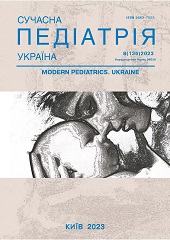Onychocryptosis in children: literature review and generalization of treatment experience at the clinic of pediatric surgery of National Pirogov Memorial Medical Universiy
DOI:
https://doi.org/10.15574/SP.2023.136.94Keywords:
onychocryptosis, ingrown nail, treatmentAbstract
Onychocryptosis in children is a medico-social problem, since the suffering associated with this pathology affects the general state of health and the formation of children's psyche, which significantly worsens the quality of life in pediatric practice.
Purpose - to highlight the problem of treatment of an ingrown toenail in children to determine the optimal therapeutic and diagnostic tactics.
The article analyzes the possible causes and risk factors of ingrown toenails, describes the symptoms of this disease. The experience of treating onychocryptosis in children is considered, namely, the methods of surgical intervention, taking into account the frequency of relapses, treatment terms, levels of trauma, and cosmetic results. The work summarizes the experience of treating 167 patients with onychocryptosis who were treated in the pediatric surgery clinic of the National Pirogov memorial Medical University from 2011 to 2020. A clinical case of operative treatment of onychocryptosis using the Schmiden method is demonstrated.
Conclusions. The appearance of an ingrown toenail in children is explained by various congenital and acquired causes. Onychocryptosis occurs mainly in adolescence. The choice of the method of surgical treatment depends on the severity of local pathological changes and the presence of complications, the frequency of relapses, and the duration of treatment.
The research was carried out in accordance with the principles of the Helsinki Declaration. The informed consent of the patient was obtained for conducting the studies.
No conflict of interests was declared by the authors.
References
Catalfo P, Musumeci ML, Lacarrubba F, Dinotta F, Micali G. (2018). Congenital malalignment of the great toenails: a review. Skin Appendage Disorders. 4(4): 230-235. https://doi.org/10.1159/000484943; PMid:30410889 PMCid:PMC6219217
Hrytsenko YeM, Hrytsenko MI. (2017). Sposib likuvannia vrosloho nihtia u nemovliat. Patent No. 118492. Patentne vidomstvo. URL: http://repository.pdmu.edu.ua/bitstream/123456789/8487/3/VrosliyNigot.pdf4.
Lipner SR, Scher RK. (2016). Congenital malalignment of the great toenails with acute paronychia. Pediatric Dermatology. 33(5): e288-e289. https://doi.org/10.1111/pde.12924; PMid:27396767
Starace M, Alessandrini A, Piraccini BM. (2018). Nail disorders in children. Skin appendage disorders. 4(4): 217-229. https://doi.org/10.1159/000486020; PMid:30410888 PMCid:PMC6219237
Vergun A, Chulovskyj Y, Shalko I, Kit Z, Moshchynska O, Lytvynchuk M et al. (2017). Onychomycosis with nail incarnation: complex surgical treatment (clinical analysis). Mizhnarodnyi naukovyi zhurnal Internauka. 12: 19-24.
Verhun AR, Parashchuk BM, Kit ZM, Verhun OM, Krasnyi MR, Makahonov IO. (2020). Khirurhichna mikotychna onikhopatolohiia, asotsiiovana iz vtorynnoiu inkarnatsiieiu nihtiv: kompleksne likuvannia, avtorski pohliady. Ukrainski medychni visti. 1: 64-67.
Zhurylo YP, Lytovka VK, Sopov HA, Latishov KV, Ynozemtsev YN. (2012). Problema vrossheho nohtia u detei. Zdorove rebenka. 2(37): 139-141. https://doi.org/10.22141/2224-0551.0.2.37.2012.100634
Downloads
Published
Issue
Section
License
Copyright (c) 2023 Modern pediatrics. Ukraine

This work is licensed under a Creative Commons Attribution-NonCommercial 4.0 International License.
The policy of the Journal “MODERN PEDIATRICS. UKRAINE” is compatible with the vast majority of funders' of open access and self-archiving policies. The journal provides immediate open access route being convinced that everyone – not only scientists - can benefit from research results, and publishes articles exclusively under open access distribution, with a Creative Commons Attribution-Noncommercial 4.0 international license (СС BY-NC).
Authors transfer the copyright to the Journal “MODERN PEDIATRICS. UKRAINE” when the manuscript is accepted for publication. Authors declare that this manuscript has not been published nor is under simultaneous consideration for publication elsewhere. After publication, the articles become freely available on-line to the public.
Readers have the right to use, distribute, and reproduce articles in any medium, provided the articles and the journal are properly cited.
The use of published materials for commercial purposes is strongly prohibited.

